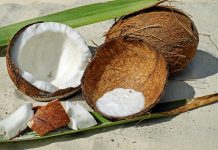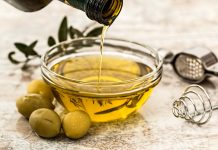
Because of high cholesterol and high triglycerides, I am trying to stick to a diet that is low in saturated fat. The other night I cooked 1/2 chicken breast. The nutrition book that I have shows that breast to have 250 calories and 3.86 grams of saturated fat. Unfortunately, the book does not tell if that is with or without skin. Of course, I removed the skin prior to cooking. The book also did not specify if that was raw, fried, roasted or broiled. I broiled it. Is there any “rule of thumb” to determine the amount of saturated fat in broiling as opposed to other methods of cooking?
Secondly, is there any place that you know of on the Internet where I can obtain information on how many grams of saturated fat there are in various foods? Any information would be appreciated. Thank you.
There is no rule of thumb for calculating saturated fat from the amount of fat in a food. The food source, cooking method, and serving size determine saturated fat content. Saturated fat is found mostly in animal foods like meat, cheese, butter, and milk, but it is also found in tropical oils like palm and coconut oil. The fat content of your eating plan should be between 25% and 30% of your total calories.
The USDA lists a 3 ounce roasted chicken breast without skin as having 142 calories with 0.9 grams saturated fat and a 98-gram chicken breast with skin has 193 calories with 2.1 grams saturated fat. There is no data for broiled chicken breasts. Interestingly, chicken breast has almost as much cholesterol whether you eat the skin (82 milligrams) or not (73 milligrams)!
If you are overweight, you should lose weight. Saturated fat, trans fat, total fat and weight need to be reduced to lower your cholesterol. As to your high triglycerides, you should eliminate alcohol and simple sugars to get your triglycerides down.
As to sources of saturated fat information on the Internet, here is a list from the USDA of the saturated fat content in foods. Otherwise, you can look up one food at a time by searching the USDA National Nutrient Database. Otherwise look for nutrition analysis software that will track your calories, saturated fat, percent fat and alcohol in the foods you eat.


